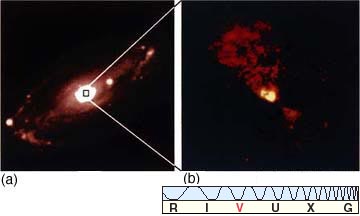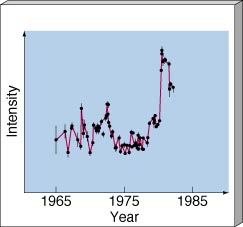In 1943 Carl Seyfert, an American optical astronomer studying spiral galaxies from Mount Wilson Observatory, discovered the type of active galaxy that now bears his name. Seyfert galaxies are a class of astronomical objects whose properties lie between those of normal galaxies like the Milky Way and those of the most violent active galaxies known. This fact suggests to some astronomers that Seyferts represent an evolutionary link between these two extremes. The spectral lines of Seyfert galaxies are usually substantially redshifted, telling us that most Seyferts reside at large distances (hundreds of megaparsecs) from us.
(Sec. 24.5) However, a few lie just 20 or 30 Mpc away.
Figure 25.2 shows two optical images of a typical Seyfert galaxy. A casual glance at a long-exposure photograph of a Seyfert (Figure 25.2a) reveals nothing strange. Superficially, Seyferts resemble normal spiral galaxies. However, closer study of Seyferts reveals some peculiarities not found in normal spirals.

Figure 25.2 Photographs of a Seyfert galaxy (NGC 5728) (a) from the ground and (b) from Earth orbit. The enlarged view in (b) of two cone-shaped beams of light shows a group of glowing blobs near the galaxy's core, perhaps illuminated by radiation arising from the accretion disk of a black hole. This object is about 40 Mpc away—one of the closest active galaxies known.
First, maps of Seyfert energy emission show that nearly all the radiation stems from a small central region known as the galactic nucleus. This region lies at the center of the overexposed white patch in Figure 25.2(a); it is shown in more detail in Figure 25.2(b). Astronomers suspect that a Seyfert nucleus may be quite similar to the center of a normal galaxy, such as the Milky Way or the Andromeda Galaxy, but with one very important difference: the nucleus of a Seyfert is 10,000 times brighter than the center of our Galaxy. Indeed, the brightest Seyfert nuclei are 10 times more energetic than the entire Milky Way.
Second, Seyfert galaxies emit their radiation in two broad frequency ranges. The stars in the Seyfert's galactic disk and spiral arms produce about the same amount of visible radiation as those of a normal spiral galaxy. However, most of the energy from the Seyfert's nucleus is emitted in the form of invisible radio and infrared radiation, which cannot be explained as coming from stars—it must be nonstellar in origin.
Third, Seyfert spectral lines bear little or no resemblance to those produced by ordinary stars, although they do have many similarities to the spectral lines observed toward the center of our own Galaxy. (Sec. 23.7) Seyfert spectra contain strong emission lines of highly ionized heavy elements, especially iron. The lines are very broad, indicating either that the galaxy's gases are tremendously hot (more than 108 K) or that they are rotating very rapidly (at about 1000 km/s) around some central object.
(Sec. 4.4) The first possibility can be ruled out, since such a high temperature would cause all the gas to be ionized, in which case no spectral lines would be produced. Thus, the broadening indicates rapid internal motion in the nucleus.
Finally, extensive monitoring of Seyfert radiation over long periods of time has shown that the energy emission often varies over time. Figure 25.3 shows an example of luminosity variations for a typical Seyfert. Such radiative changes are unlike anything found in the Milky Way or in any other normal galaxy. A Seyfert's luminosity can double or halve within a fraction of a year.

Figure 25.3 The irregular variations of a particular Seyfert galaxy's luminosity over a period of two decades. Because this Seyfert, called 3C 84, emits most strongly in the radio part of the electromagnetic spectrum, these observations were made with large radio telescopes. The optical and X-ray luminosities vary as well.
These rather rapid fluctuations lead us to conclude that the source of energy emissions must be quite compact. As mentioned in Chapter 22 (in the context of luminosity variations in neutron stars and black holes), for astronomers to be able to detect a coherent variation in brightness within a certain time interval, the source of radiation must be smaller in size than the distance traveled by light during that interval. (Sec. 22.3) Otherwise, the intensity variations would be blurred, not sharp, as observed. Simply put, an object cannot "flicker" in less time than radiation takes to cross it. Because the rise and fall of a Seyfert's radiation usually occurs within one year, we conclude that the emitting region must be less than 1 light year across—an extraordinarily small region, considering the amount of energy emanating from it. High-resolution interferometric radio maps of Seyfert cores generally confirm this reasoning.
(Sec. 5.5)
The rapid time variability and large radio and infrared luminosities observed in Seyferts together imply violent nonstellar activity in their nuclei. This activity may well be similar in nature to processes occurring at the center of our own Galaxy, but its magnitude is thousands of times greater than the comparatively mild events within our own Galaxy's heart. (Sec. 23.7)